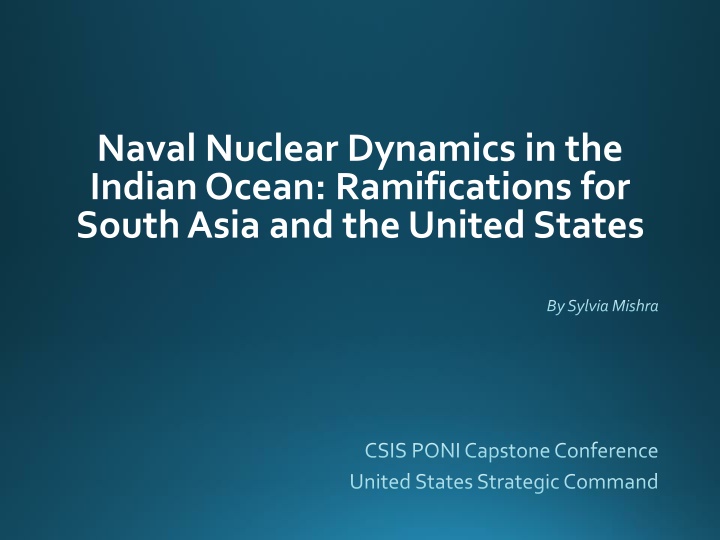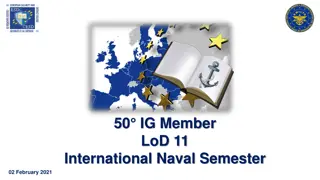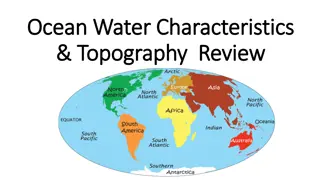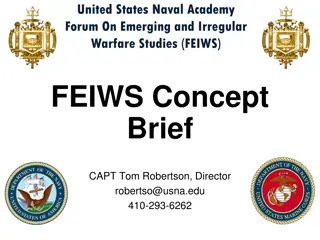Naval Nuclear Dynamics in the Indian Ocean: Implications for South Asia and the United States
Delve into the complexities of naval nuclear dynamics in the Indian Ocean, exploring strategic developments, India's sea-based deterrence efforts, and the geopolitical implications for South Asia and the United States. Assess the simultaneous rise of China and India, the influence of major chokepoints on global trade, and the evolving maritime strategies of key players in the region.
Download Presentation

Please find below an Image/Link to download the presentation.
The content on the website is provided AS IS for your information and personal use only. It may not be sold, licensed, or shared on other websites without obtaining consent from the author.If you encounter any issues during the download, it is possible that the publisher has removed the file from their server.
You are allowed to download the files provided on this website for personal or commercial use, subject to the condition that they are used lawfully. All files are the property of their respective owners.
The content on the website is provided AS IS for your information and personal use only. It may not be sold, licensed, or shared on other websites without obtaining consent from the author.
E N D
Presentation Transcript
Naval Nuclear Dynamics in the Indian Ocean: Ramifications for South Asia and the United States By Sylvia Mishra CSIS PONI Capstone Conference United States Strategic Command
Contents Introduction Choppy Waters: Dynamics in the Indian Ocean India s Sea-Based Deterrence Nuclear Weapons at Sea Deepening India-US Naval Cooperation Conflict Management and Escalation Control Conclusion
Choppy Waters: Dynamics in the Indian Ocean Strategic developments: simultaneous rise of China &India A critical bridge between the Persian Gulf and Western Pacific; 80% world s seaborne trade; major chokepoints ; 50% of the world s container traffic United States: Bases in Indian Ocean Diego Garcia for intervention in Iraq and Afghanistan; deployment of Naval Task Force 152 anti-piracy missions Nuclear rivalry between India-Pakistan & India-China acquiring maritime dimension; preference for dual-use platforms China-Pakistan maritime entente; OBOR; Chinese military bases around Indian periphery
Indias Sea-Based Deterrence India s ongoing efforts to modernize its military with particular naval focus; Sea control and power projection in IOR Primary objective of maritime security strategy: to deter conflict and coercion against India Ensuring Secure Seas: India s Maritime Security Strategy Oct 2015 (re- prioritized & reformulated) Deterrence is first priority & war fighting is second Survivable second-strike capability is priority for India; SSBN Force Critical enabler of No-First Use Advanced Technology Vessel (ATV) project to design and build nuclear- powered submarines; INS Arihantcommissioned into service India s new K-4 nuclear capable, submarine-launched ballistic missile (3,500 Kms); K-15 (1,500 Kms)
On western side, Indian K-15 and K-4 SLBM range covers a major portion of Pakistan as shown below: Source(s): Carnegie Endowment
On eastern side, Indian K-15 SLBM range does not reach Chinas border; K-4 SLBM does not effectively cover northern Chinese cities as shown below: Source(s): Carnegie Endowment;
Nuclear Weapons at Sea Evolving Chinese naval and air capabilities; supported by a robust (C4ISR) architecture, asymmetric capability to project power in IOR Pakistan s establishment of a Naval Strategic Force Command in 2012; Pakistan tested nuclear-capable Babur-3 submarine-launched cruise missile (SLCM) from a submerged platform Commingling of Forces: when Pakistan deploys both conventional and nuclear Agostas, how will adversaries know the difference? Does Pakistan have a sufficient & robust Command and Control infrastructure to safely and reliable manage a submarine based nuclear force?
Naval Capability Snapshot Particulars Submarines China Naval Capability - SSBN Type 094: 4 - SSN Type 093/093A: 3 - Kilo SS: 12 - Type 035 SS: 9 - Type 039 SS: 13 - Type 039A SS: 14 - Type 032 SS: 1 - Total: 56 (41 are modern) One with a capacity for 24 J-15 fighters, 6 anti- submarine warfare helicopters, 4 airborne early warning helicopters and 2 rescue helicopters: Total 36 aircrafts India Naval Capability - Type 877EM SS: 9 - Type 209 SS: 4 - Akula-class SSN: 1 - Scorpene-class SS: 1 trials (5) under construction - Arihant-class SSBN: 1; and 3 under construction Pakistan Naval Capability - S20 SS: 8 (yet to be finalized) - Agosta 90B SS: 3 - Agosta 70 SS: 2 - SSBN: 1 projected (?) One STOBAR carrier with another STOVL carrier to be decommissioned. One more are under construction. None Aircraft Carrier - - - - - - - - - - - - - - - Sovremenny: 4 Type 052A: 2 Type 051B: 1 Type 052B: 2 Type 052C: 6 Type 051C: 2 Type 052D: 3 Total: 20 Type 053 H2G: 4 Type 053H3: 10 Type 054: 2 Type 054A: 19 Total: 35 Type 071 amphibious ship: 4 Development of floating sea bases underway 10 Destroyers Type -21 destroyers: 6 Navy Destroyers 9 Frigates and 7 more under development 4 Type 053H3 Frigates Frigate Commissionings Replenishment and fleet tankers 2 Landing craft Amphibious ships and floating bases Source(s): Compilation of data from multiple public sources NTI, Pakistan Navy, CRS;
Deepening India-US Naval Cooperation Important determinants of Delhi s strategy: geography, nuclear protective bastion; net security provider India-US cooperation on shared ASW capabilities ; India s acquisition of P-8 Maritime Patrol Aircraft- increased surveillance & engagement capabilities; anti-submarine helicopters; LEMOA; White-shipping agreement; MDA Installation of underwater sound surveillance sensors (SOSUS); Integrate with existing US-Japan Fish Hook network MALABAR; Expanding talks to include Japan and Australia; Raising the complexity of naval exercises; Time to Revisit Quadrilateral Security Dialogue? Can India and the US work together on disruptive technologies UUVs?
Ships from the Indian navy, Japan Maritime Self-Defense Force and U.S. Navy are underway together during a group sail signifying the end of Malabar Exercises 2016 Source(s): Wikimedia Commons;
Conflict Management and Escalation Control Active patrols by nuclear-powered Chinese subs purportedly for piracy operations in the IOR are intensifying misperceptions Notable shifts in Pakistan s nuclear doctrine, from minimum deterrence to second strike capability towards expanding nuclear weapons Pakistan s inclusion of both strategic and tactical weapons Triggers for crisis escalations from flashpoints terrorist attacks on India; provocations along LOC Concerted efforts to improve nuclear signaling and strengthening crisis stability; Create CBMs in maritime domain
Conclusion India s SSBN offers an unshakeable second strike , increases credibility of NFU and bolsters deterrence IMSS-2015 illustrates India s intension of using nuclear deterrent only as a retaliatory measure of last resort Pakistan s commingling of nuclear & conventional assets buttress uncertainty; complicates security in IOR China-Pakistan maritime axis destabilizing South Asia s delicate security fabric; Chinese naval deployments in Karachi & Gwadar US looks to India to play a more active role in Asia-Pacific; growth in capability will enhance India s ability to step into that role; enhancing potential of US-India strategic partnership























